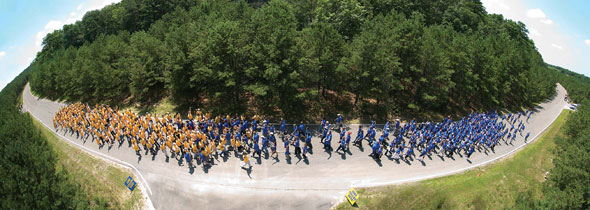Human ions collide for charity at BNL
 |
| Photo courtesy of Brookhaven National Laboratory |
The blue team rounded the bend first—sweaty, jovial, and headed toward the halfway point of the 2.4-mile path circling Brookhaven National Laboratory's Relativistic Heavy Ion Collider.
Suddenly, from the other direction, the yellow team emerged. A cheer erupted from the crowd as the two bunches of human ions pushed forward, with raised hands, to collide in a sea of blue and yellow T-shirts.
The humans mimicked the actions of their ion counterparts in the tunnel below, albeit 168 million times slower than the particles and in numbers far smaller than the one billion ions in each RHIC bunch. Still, the simulation accomplished what pure nuclear physics experiments cannot: raising the collider's visibility while raising money for a good cause.
More than 400 life-sized particles, whose day jobs range from Brookhaven graduate student to visiting scientist, participated in August's "Collide-the-Ions" walk to thank a local company for its help in keeping RHIC running.
In 2006, RHIC's scheduled polarized-proton run was almost canceled due to budget constraints and an unexpected increase in electricity costs. But thanks to $13 million provided by several partners at Renaissance Technologies, Inc., RHIC and its 1000 visiting researchers were able to continue their explorations.
To recognize Renaissance's help, Brookhaven Science Associates—the company that manages and operates the lab—decided to pass the good fortune along. For every participating walker, BSA contributed $10 to the Autism Science Foundation.
Sloppier, slower, and even more competitive than their tightly packed ion counterparts, the human bunches proved scientifically accurate in at least one respect: Each pass of RHIC's ion bunches produces just one actual collision, at most—and many times none. Most of the ions fly past each other unharmed. None of the human ions hit head-on, either, and all left intact.
Kendra Snyder
Click here to download the pdf version of this article.






